
The Citizen Promaster Aqualand Depth Meter has existed in evolving forms for many years as a popular dive watch choice for those looking to measure their depth as well as the time under water. As an amateur diver and watch lover, I make use of my dive/tool watches to actually dive. This is especially interesting, since even with the omnipresence of dive computers, a dive watch, in my opinion, remains important while diving as it provides the secondary method (backup plan) for timing that any diver knows is critical and potentially life saving if something were to go awry.
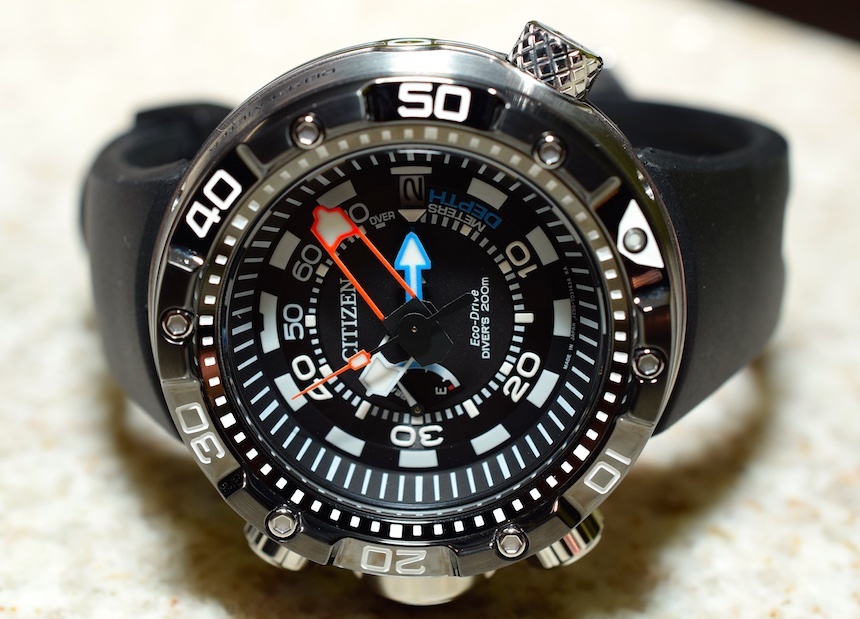
Some of the most complicated modern mechanical dive watches are the ones that have depth gauges. Not that typical dive computers do not include a depth measurement feature, but again, as a secondary source of redundancy, the dive watch with depth gauge is highly usable and practical.
One of the most affordable, yet feature packed, dive watches with a depth gauge is the Citizen Eco-Drive Promaster Aqualand Depth Meter reference BN2029-01E (or Citizen Promaster Aqualand for short). As I venture into eventually becoming a master diver, I did not hesitate when Citizen wanted to send me one exemplar for my second trip to Key Largo, FL, in the past three years to dive in the marine sanctuary there. What follows here is a recap of three days diving with the Citizen Eco-Drive Promaster Aqualand diver.
Citizen is well known for their quartz watches, however, the Citizen company has a long history in horology dating back to 1924 producing pocket watches under the name Citizen but branded by Shokosha Watch Research Institute.
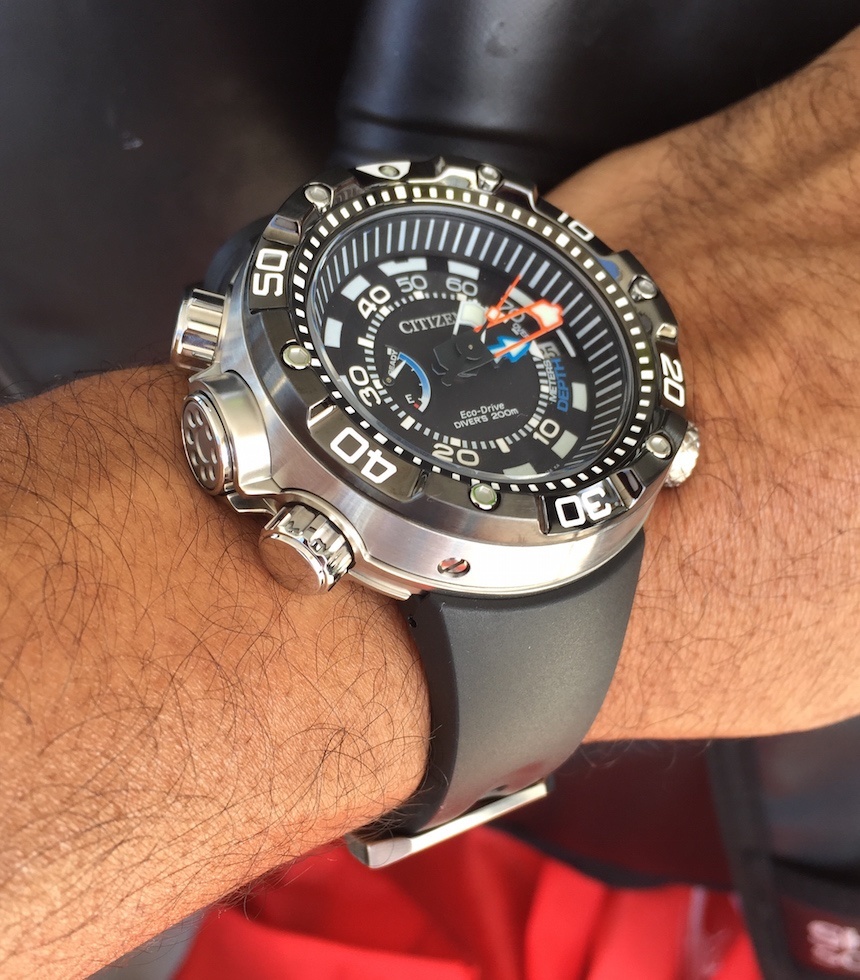
Currently the most popular lineup from Citizen stems from their Eco-Drive watches which use a solar cell on the dial to charge a battery and fuel an accurate quartz movement. The great part about this technology is that watch can be powered by any light, solar, home light, and so on, and the battery is typically rated and guaranteed for a the lifetime of the watch. This makes for an accurate watch that requires very low maintenance.
In the model I received, containing the Eco-Drive J250 movement, one charge will typically hold the watch working for 180 days and more (by going to standby mode) if the watch is kept in a poorly lit enclosure. So far, I can attest that the battery charging has worked perfectly as the watch remained pretty much fully charged (easily seen by the power reserve indicator on the dial) since I received it a couple of weeks before the trip, and the sun in Florida constantly recharged it as I used it for diving.

What makes the Citizen Promaster Aqualand particularly usable to me for diving are two unique features that are most commonly found in either dive computers or mechanical watches ten times the price of this one: a depth gauge with indication of current depth and max depth.

If you look carefully at the dial above, you will see that besides the two skeletonized hands in white (indicating hours) and orange (indicating minutes), there are two other smaller hands shaped as pointy arrows in blue and purple. The first one indicates the current depth in meters and the other moves along but remains at the greatest depth achieved.
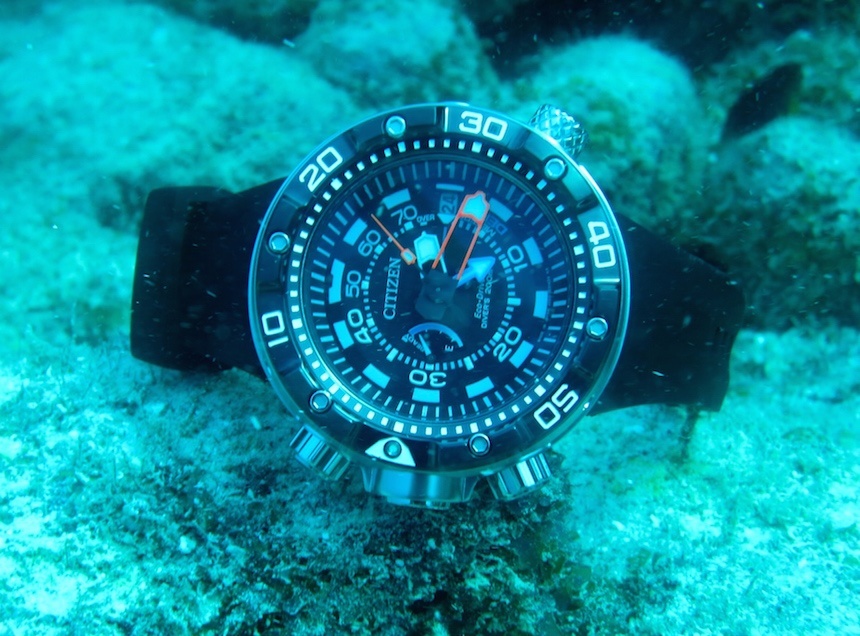
For instance, in the picture above, you can see that I was at about 8 meters (26 feet) depth, whereas my max depth at the time was about 10 meters (or about 33 feet). What makes this feature interesting for divers is the ease of knowing what max depth you have achieved during a dive as you check for your dive time. This is important as one of the main factors of staying in the no-decompression limits for a dive are your maximum depth achieved and the amount of time spent at bottom as well as overall time in water and prior dives. With some calculation and remembering or checking the decompression tables, with the Citizen Promaster Aqualand Depth Meter you are able to accurately determine if you should perform decompression stops.
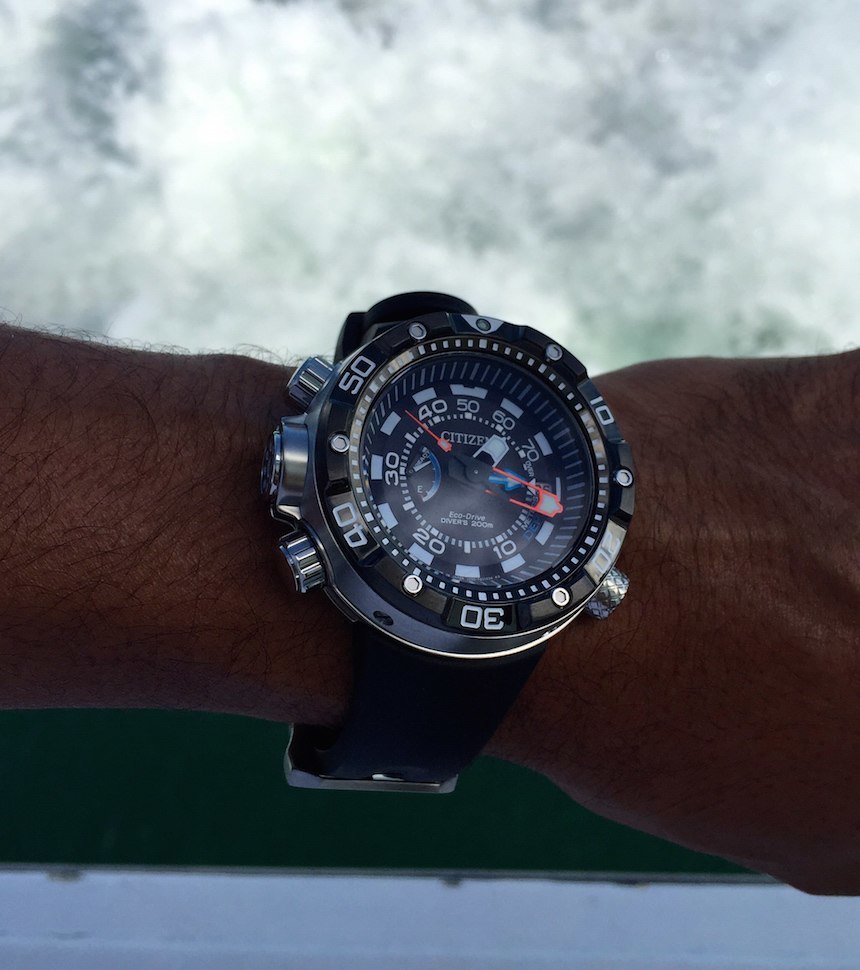
While most recreational divers tend to plan dives with no-decompression stops, having the knowledge that you need that decompression stop readily during a dive makes for a safer experience. And again, while I realize that a modern dive computer will readily give you this information and much more, there remain two realities that still make the Citizen a great companion for me.
Firstly, most dive computers have busy multiple dials with lots of information, including air reserve and compass, which are two necessary pieces of info when diving; I therefore tend to use the computer primarily for these information first. Secondly, dive computers require batteries and are pretty useless if they run out of juice. So while not a mechanical device and thus not a true alternative secondary source of information, the Citizen rechargeable Eco-Drive technology still makes for an excellent fault-tolerant secondary source for me.
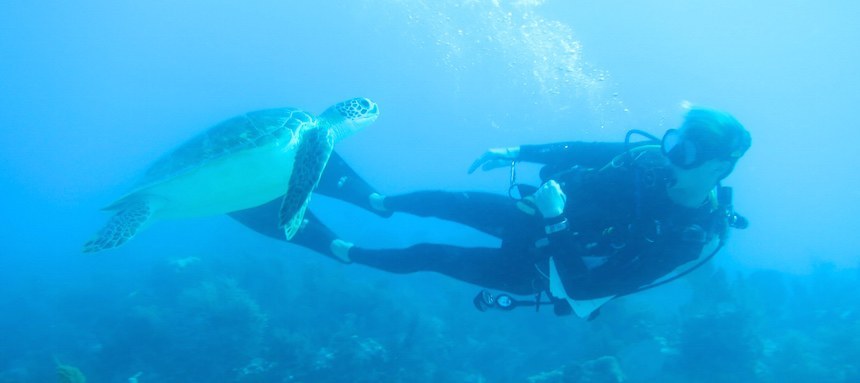
Additionally, a wonderful feature of the Citizen Promaster Aqualand Depth Meter is the fast ascent indicator. Essentially, the watch will automatically start beeping (which one can hear easily underwater) whenever your ascent speed is greater than 33 feet (10 meters) per minute. This is a feature I activated more than a few times during my second dive, when the weather was inclement and thus the visibility was terrible, and even at 30 and 40 feet, the waves on the surface would affect the deeper waters. Moving up and down was not infrequent as we tried to move to areas with less coral and making sure we stayed far from the fragile marine life.
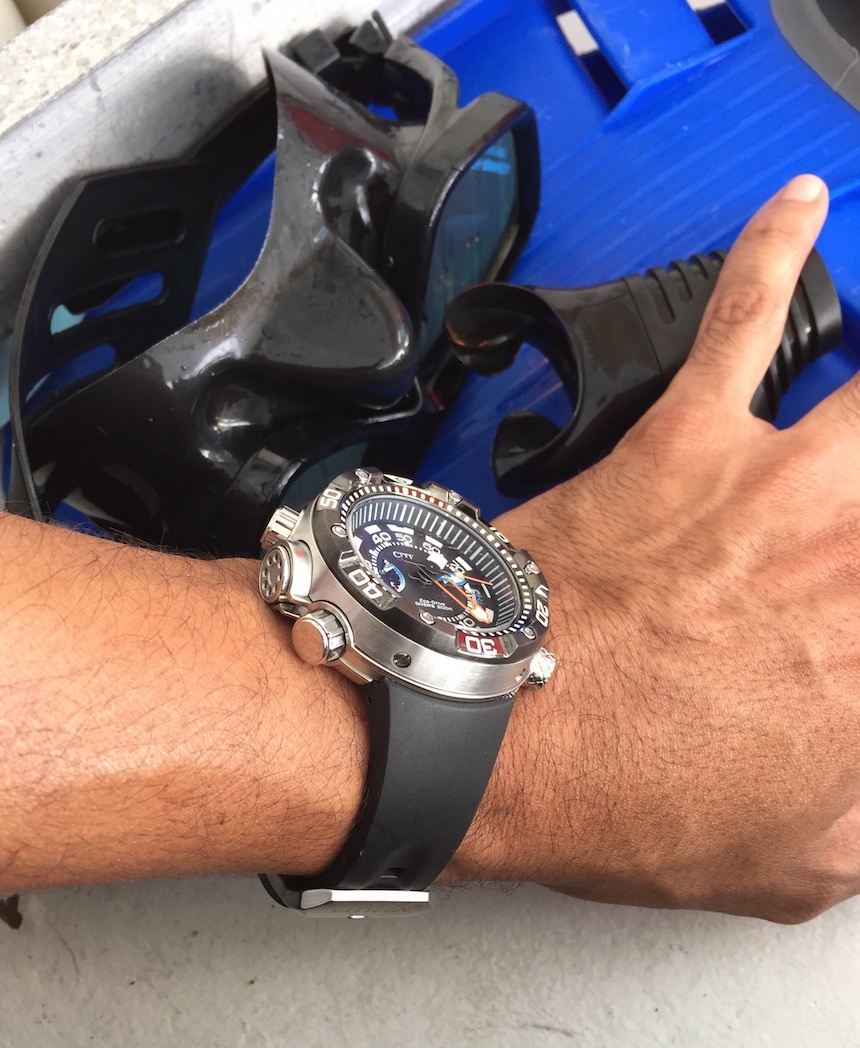
The last thing to cover is the basic shape of the Citizen Promaster Aqualand Depth Meter watch. It’s the classic round “tuna-can” style shape that Seiko and Citizen dive watches are famous for. This makes for a dial that is recessed and well protected by the unidirectional bezel. The sword teeth three dimensional design of the bezel make it easy to grasp and turn. Since the bezel seats 2 to 3 mm higher above the anti-reflective mineral crystal, it does a good job of covering the dial face while giving a truly instrument look to the watch. The rest of the dial is no-nonsense dive watch, with indicators well situated, while the inner part of the dial contains the depth gauge indicators in meters up to 70 meters, or 230 feet (typically the limit for most recreational diving). The watch itself is water resistant to 200 meters.
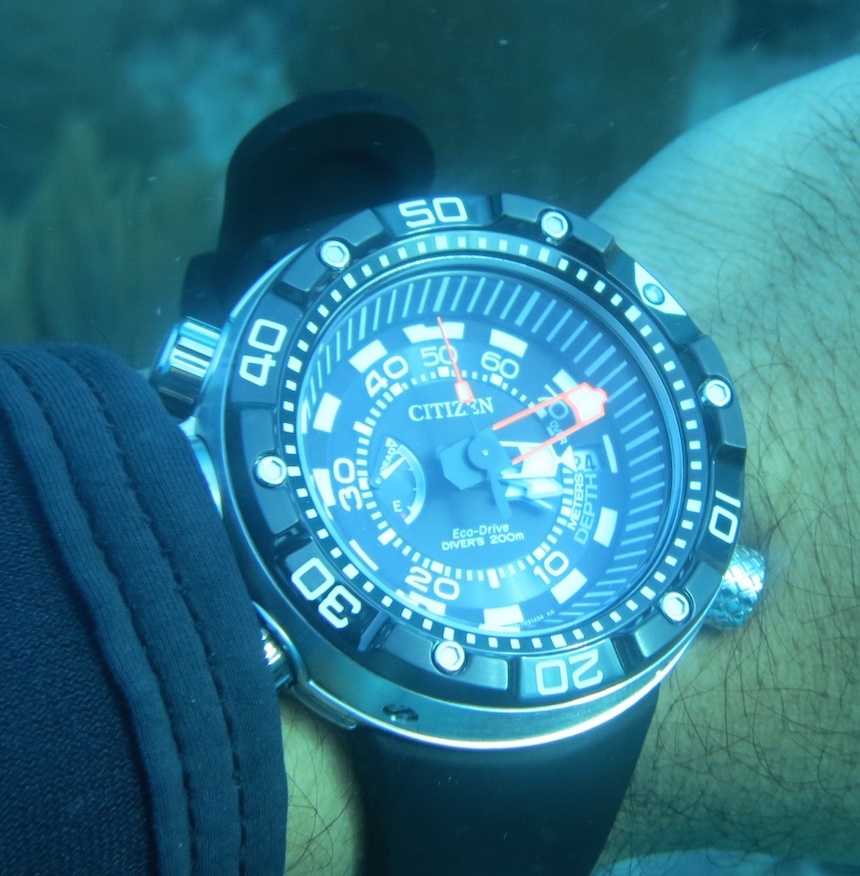
Finishing the case are the screw-down crown to control setting the time and quick setting of the date located at 4 o’clock; while two other crowns (at 8 o’clock and 10 o’clock) can be used to ask for the maximum depth on demand when the watch is outside water and to reset it to zero. Between the two crowns, at 9 o’clock, there is the depth gauge sensor which does not turn, but gives a instrument look to the watch. The depth gauge is automatically activated once the watch is submerged in water, as a sensor, flat on the case, located at 7 o’clock activates the mechanism when wet.
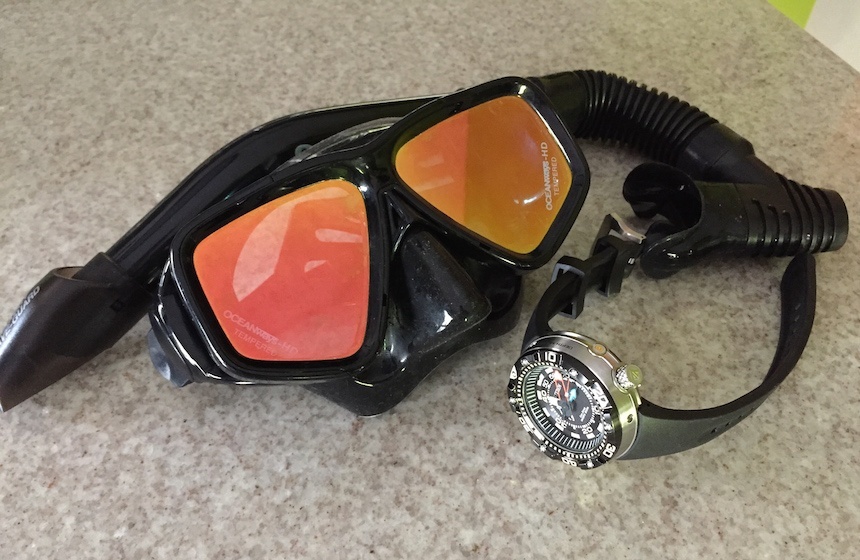
At 43 mm wide and a bit more than 15 mm high, the Citizen Promaster Aqualand Depth Meter is a large watch, however, it actually wears quite well. The primary reason is that the lugs are almost completely integrated into the case, allowing the well built polyurethane rubber strap to wrap ones naked wrist above water and tightly around a wet suit when diving. The strap is also long, with two keepers. The first one is locked, while the other can move. Together, they keep the strap perfectly around ones wrist, with or without a wet suit.
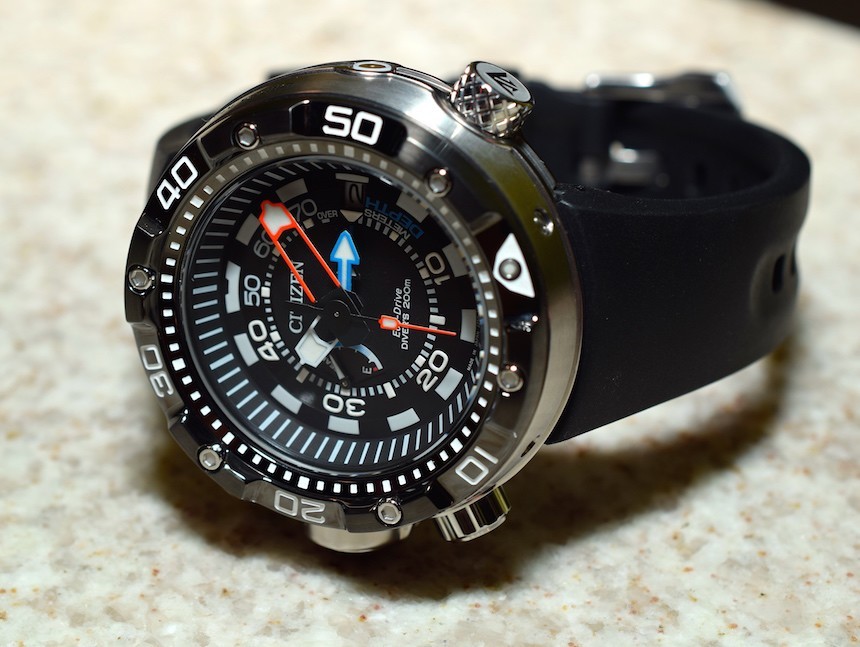
At an MSRP of $950, the Citizen Promaster Aqualand Depth Meter is a bargain for what it provides, and when one compares it with the other similarly featured-watches in this category. While I would have a hard time wearing this watch day-to-day, due to it’s imposing, yet wearable, stature, it felt great on the dive boat and during post-dive activities. The extremely legible dial and instrument look, make it blend perfectly with my other dive equipment. citizenwatch.com
Necessary Data
>Brand: Citizen
>Model: Promaster Aqualand Depth Meter ref. BN2029-01E
>Price: $950
>Size: 50 mm diameter x 18 mm high (not much more than 52 mm lug to lug)
>Weight: 175g on strap
>Would reviewer personally wear it: Yes, during dives and diving excursions.
>Friend we’d recommend it to first: Anyone new to diving or the seasoned amateur diver who lacks a dive watch and is dependent on his/her dive computer solely.
>Worst characteristic of watch: Lack of deployment buckle option. The strap is great but I miss the quick and easy removal of my other mechanical dive watches.
>Best characteristic of watch: The rapid ascent indicator. It works brilliantly with an audible note that one can hear easily yet does not pollute the environment or annoy your dive buddy.
